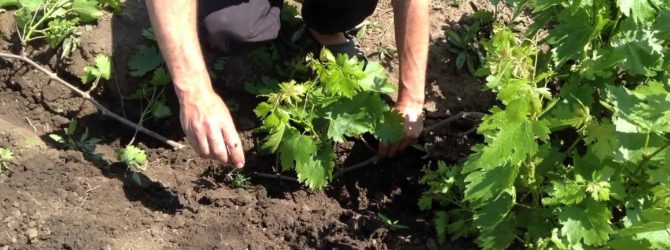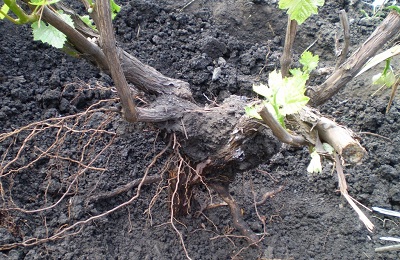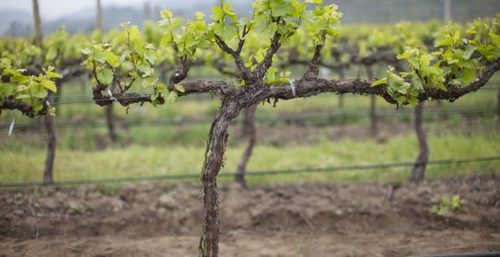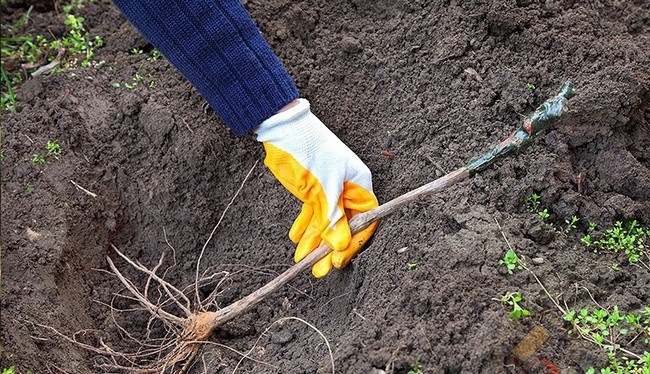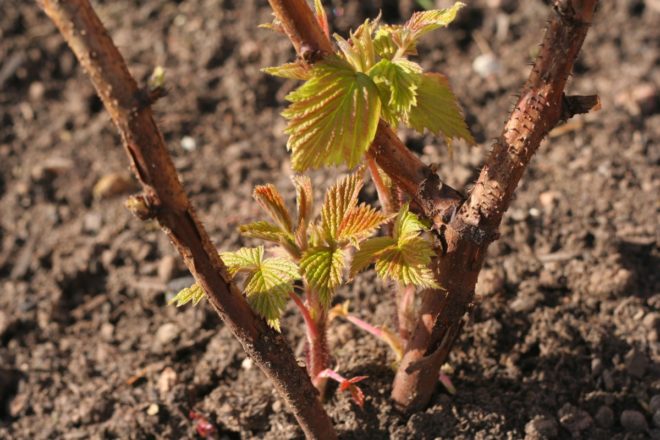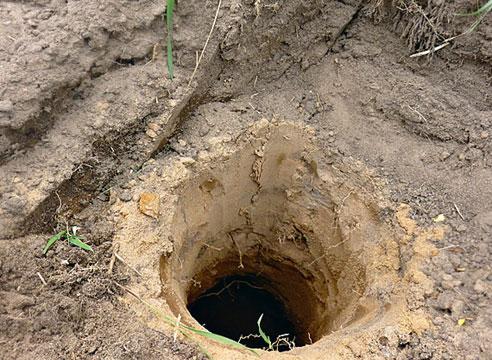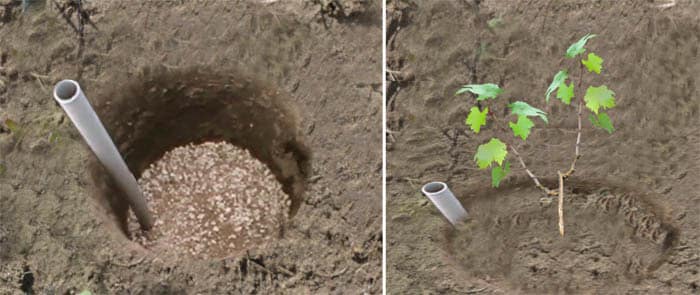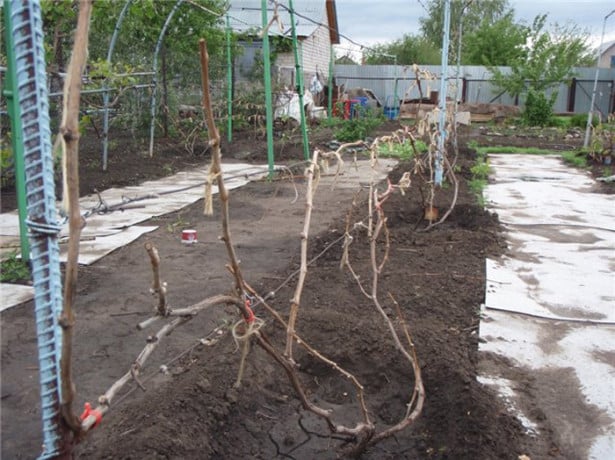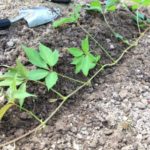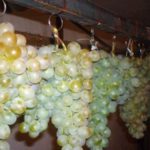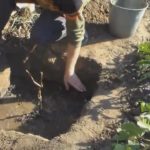Transplanting old grapes to a new place every summer is not a necessary measure. More often in this way they try to correct mistakes made during the initial planting. And here, inexperienced gardeners must do everything correctly so as not to aggravate the situation.
Why replant grapes?
The root of the problem is often hidden in an unsuccessful choice of site for the future vine, but in general the reasons for replanting can be described as follows:
- little light, draft, poor soil;
- bushes are planted too densely;
- the presence of neighbors who have a depressing effect on the vine;
- planned transfer of seedlings to another part of the site.
Before relocating grapes, you need to weigh the pros and cons again. The following are taken into account as counterarguments: injured (lost part of the root system) bushes often die, the taste of the berries will change, fruiting is not guaranteed in the first 2-3 years after transplantation, seedlings become susceptible to diseases.
When is the best time to replant grapes to a new location?
To successfully carry out the procedure, there are certain rules, the implementation of which will minimize the harm from the transplant.
This is the timing of the event, knowledge of when it is best to replant the bushes, as well as concern for the safety of the seedling and its roots.
It is not recommended to plant a new chubuk where grapes have already grown (and been uprooted): the soil there is poor, and pathogens may be present. The optimal time for transplantation is in early spring or late autumn, when the plant is at relative rest and is not developing. According to another rule, a bush no older than 5 years has a better chance of taking root. Damage to the root system is extremely undesirable: therefore, they dig up and transport the grapes with a lump of earth.
The top (vine) will have to be trimmed to maintain balance with the bottom. Before replanting, they prepare the future place of residence: they dig it up, fertilize it, and clear it of weeds and pests.
Features of the grape root system
The development of the lower, hidden underground part of the seedling and adult plant depends on the characteristics of the variety, its age, nutrition, and the location of aquifers.There are 2 stages of root growth: until approximately mid-summer (July) and from autumn (September), until falling asleep. When the earth warms up to 17-21 °C (third decade of June), the rate of formation of the root system reaches its climax. The roots begin to grow before the buds hatch (or at the beginning of the process).
Further, the growing season and the formation of foliage are accompanied by the simultaneous strengthening of the underground part and branching of the roots. If the plant has enough moisture and microelements in the soil, then in September the 2nd stage of growth begins, which ends when the temperature of the root layers drops to 8 °C.
Drought significantly affects the development of grapes: in this case, root growth is limited to one stage. The main factor restraining and determining the development of the lower part of the plant is moisture. This is the difference between grapes grown in the Moscow region and Rostov: in the first case, the seedling will grow, gradually slowing down, until the end of September, due to higher soil moisture. Exactly how the root system will be located and its type depends on the variety and growing conditions.
Generally speaking, there are 2 types:
- Intensive.
- Extensive.
In the first case, the roots are short, but branched, stretching along the aquifers. In the second, they are long and less developed laterally, sometimes reaching 3.5 meters (Cabernet and Sauvignon varieties in Crimea). In profile, the system has 1, 2 and 3 maximums: each of them is tied to specific growing conditions.
We take into account the age of the bush
The most favorable age for the growth of the root system is considered to be up to 5 years. In the first year of life, the soil, as well as the quality of care for the bush, influence the characteristics of its root system.Chubuk develops 3 types of roots: with a depth of up to 15 centimeters (dew), medium (sometimes in several tiers) and heel (the deepest).
In turn, in the cortical process, zones of active development, absorption and conduction are distinguished. Each of them has its own specific functions that are responsible for the overall growth of the seedling. Next, we will consider the features of transplantation related to the age of the shrub. Young grapes, which are no more than 5-6 years old, tolerate moving to a new place of residence well and have a relatively undeveloped root system (the risk of damage is minimal). It should be borne in mind that in practice the “safe” time period comes down to 3-4 years, but first things first.
In an adult or old (10 years and above), the underground part extends deeper and laterally, making it more difficult to dig out completely. In the first year, it is better not to touch the plant - let it grow and gain strength. Two-year-olds have a greater reserve of vitality, but at the same time they also have more branched root shoots. A circle with a radius of 30 centimeters is marked around the stem - this will be the digging area. The depth is up to 60 centimeters, and the upper part is cut off to leave 2-3 eyes.
The chances of a two-year-old seedling surviving in a new place are quite high.
Grapes aged 3 years in the underground part reach almost 1 meter, approximately the same size of its spread to the sides. Such bushes are dug 50 centimeters around and 70-80 centimeters deep. When the plant is planted, prune it, leaving no more than 4 eyes.
With each subsequent year of life, the task becomes more complicated: for example, replanting 4-5-year-old chibouks without damaging the roots is impossible - they diverge deep and wide, concentrating in the 60-centimeter zone.Therefore, you need to capture as much of the earthen clod as possible, digging in 0.5 meters to the sides. The eyes are thinned out to 5-6. After 6 years, a critical period of development begins: for the shrub itself there is nothing bad in this, but replanting makes no sense.
The same applies to 20-year-olds and older. To renew a plant, gentle but very time-consuming methods are used to gradually “transfer” the plant, using its natural ability to take root.
According to the layering method, a long side vine and shoot are buried in the ground. Gradually (sometimes up to a year) the stepson takes root, but the connection with the mother plant remains. After a couple of years, the cuttings are separated from the bush, and the old plant is thrown away.
The “katavlak” method consists of searching for the heel root: it will become the basis for a rejuvenated bush. Old grapes are pruned as much as possible, leaving a few vines. Then they are buried, and after 1-2 years fruiting begins. Such methods make it possible to move the chubuk over short distances without using a transplant, and at the same time increase its ability to survive and renew it.
What seedlings can be transplanted?
There are no obvious restrictions on the choice of grapes for replanting by variety, size, except age. Starting from 2 years of age and ending with 5 years, all seedlings, provided that the earthen ball with roots is preserved, take root normally.
There is a practical way to preserve the root system of “old” (not too deeply entrenched) grapes:
- The bush is dug evenly and carefully until it reaches the heel.
- The resulting hole is generously filled with water until the consistency of thick sour cream is formed.
- After 3-4 hours, when the root system “gets wet”, it is relatively easy to remove it from the mud mixture with minimal damage.
The method requires extremely careful handling of the roots - you will have to separate them from the wet soil with your hands, but the result is a seedling ready for transplanting. The chances of survival of a bush treated in this way are much higher than those dug up along with a lump of soil.
How to choose a new place?
Grapes love warmth and light, and are picky in choosing neighbors - these subtleties require attention when it comes to choosing a place for replanting. Drafts are unacceptable, and moisture stagnation is also not welcome. Southern sides are preferred over others; trees that will cast shadows on bushes in the future are excluded. Aquifers should not lie too close to the surface; saline, swampy soils are not suitable.
It is also undesirable to have residues of stems, vines, and leaves in the compost for fertilizing seedlings: disease carriers could remain on them. It is better to burn this waste and use the resulting ash for feeding..
The preparation of the hole for planting deserves a separate discussion; this is done 30 days in advance (or even earlier). When preparing a hole for a bush, consider the following:
- size matters - the older the grapes, the more (and deeper) we dig;
- for sandy mixtures they are limited to 60 centimeters, for loamy soils – 80;
- in northern and cold regions they “add” depth to protect delicate roots from freezing;
- the minimum planting step is chosen from 2 to 3 meters, taking into account the varietal characteristics;
- A mixture consisting of earth, superphosphate and ammonium sulfate with ash must be poured onto the bottom (replaced with humus).
Sometimes it is advised to “feed” the bush with iron, using empty cans, nails and unnecessary metal parts. They must first be burned in a fire, then added to the hole with the seedling.
Popular transplant methods
The main task of replanting is to keep the root system of the bush intact, to provide it with normal living conditions (light, heat, moisture) in a new place and, as a result, to obtain an improved harvest of berries.
There are 3 known methods of transplantation:
- Transshipment (full lump of soil on the roots).
- With partial lump.
- With peeled roots.
The first method is the most humane and effective: the plant is painlessly transferred from one place to another, the lower part is not injured. For bushes older than 3 years, this technique is not applicable: the lump of earth becomes huge and unbearable.
Preparing grapes for transplantation by transshipment includes stopping watering (3-4 days in advance), cutting off the top part (up to 2-3 buds) and treating the cut areas with garden varnish. Next, they carefully dig around the chibouk, retreating 50-60 centimeters. Breakage of individual (longest) roots is allowed. The lump removed from the hole is transported to a new place, lowered into the hole, leveled, soil is added and lightly compacted. Pour out approximately 20-25 liters (2 buckets) of water, create a layer of mulch (compost, peat) 10 centimeters thick.
The following 2 techniques are applicable if the lump could not be preserved during the process of removing (carrying). You can also deliberately expose the roots by flooding the vine a day before transplanting. Then they dig up the bush (half a meter in all directions), working with a small spatula or a ripper with a narrow blade. It is necessary to damage the rhizome as little as possible, freeing it from the ground.
Regardless of its condition, after removal from the hole, the injured thick and also thin (up to 20 millimeters thick) areas are trimmed with pruning shears, and the dew spots are completely removed.Next, prepare a nutrient solution from 2 parts clay and 1 part cow manure, stirring it until uniform. Then they lower the bush there.
Impregnation with such a mash has 2 goals: disinfection and destruction of fungal pathogens. The vine is pruned in proportion to the condition of the root system; for significant damage and plants 10 years old or more, pruning is done “on the black head” (below ground level, completely remove the entire top). Excessive “pity” in this case can only cause harm: short-cut chibouks coated with garden varnish will produce new shoots, while untreated ones will wither.
How to properly replant grapes in summer?
Replanting shrubs in summer is considered a forced (and undesirable) measure. But if you know how to properly transplant grapes to another area and scrupulously fulfill all the requirements, then you can try. The choice of location is very important: not in the shade, on the south side of the garden or garden, without tall neighbors nearby. The transfer is carried out in compliance with the main steps: digging around the shank, cleaning the roots and preserving the clod of earth.
There are 2 methods of transplantation:
- You will need a steel or galvanized sheet 500 millimeters wide, wire and 2 shovels. It is advisable to perform the process with an assistant. The metal is rolled into a tube and the edges are secured with coils of wire. The soil layer is carefully removed until the first roots appear. Next, you need to install the pipe on top and dig around it evenly along the envelope. You should end up with a circular trench half a meter deep. Then they begin to go deeper, trying to reach the root system (50-60 centimeters from the surface).The resulting “cylinder” from the soil and the lower part of the bush will need to be carefully lifted, using shovels as levers (best shovels). Then it remains to be transferred to a new site and lowered into a pre-prepared hole.
- The second method is quite simple: to implement it you will need a shovel, humus, potassium permanganate, clay. They start by preparing the future “place of residence.” Poor soil is fed using mineral fertilizers or natural ones (manure). A seedling, carefully removed from the old site, is kept in a mixture of clay and potassium permanganate (at the same time, this helps to preserve it if the new site is far away). The upper part is cut off before planting, leaving a minimum of buds. Plant as usual, water and do not allow liquid to stagnate.
Care after transplant
After planting in a new place, grapes need care: light, watering, protection from pests. Sometimes it is useful to create a drainage system: for this, before planting a seedling, crushed stone is poured into the bottom of the hole, and a section of pipe is strengthened next to the future bush, through which useful substances will flow directly to the roots of the plant. Pruning the upper part depends on the condition of the lower part: sometimes it is useful to completely remove the vines and shoots “on the black head”, to rejuvenate the bush.

